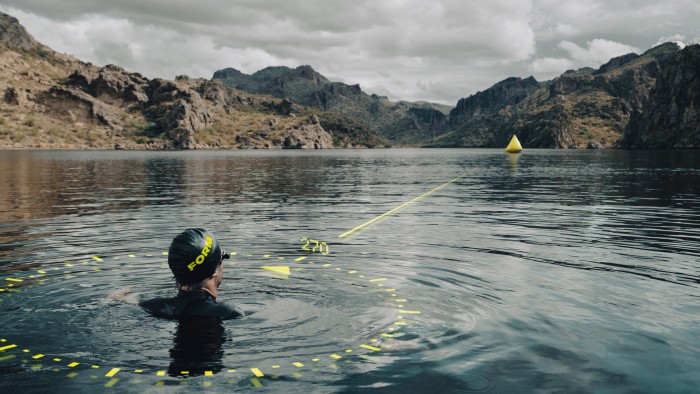Eye spy, tech to help you see more clearly

Unlock the Editor’s Digest for free
Roula Khalaf, Editor of the FT, selects her favourite stories in this weekly newsletter.
The sight stuff
Augmented reality is about putting helpful information into our field of vision. Apple’s Vision Pro may currently be the most sophisticated example of this on the market, but this pair of goggles might just be the most useful (if you’re a swimmer, anyway). Why? Well, you’ll probably be wearing goggles in any case, so it’s no more cumbersome. The information it displays (distance, time, heart rate, etc) is genuinely useful. It’s not distracting (after all, there’s not much else to look at when you’re swimming) and other swimmers won’t find it annoying.

Form Smart Swim 2 goggles
Price: £229
Click: formswim.com
It succeeds the Smart Swim 1, launched in 2019, but builds on almost 15 years of development by Vancouver-based Dan Eisenhardt (a former competitive swimmer) and his firm, with assistance from the swimming team at the University of British Columbia. It has improved silicone eye seals, mirrored lenses for use indoors and out, and an anti-fog coating – but it’s really all about the display, which projects gentle yellow text fairly centrally into your line of sight from a small, integrated pod that sits around your left or right temple (you choose). That pod also has a couple of buttons (scroll, select) to switch between stats, and an adjoining heart-rate monitor that nestles against your head.
The Form app is central to setting up dashboards of information that you might want to see during (and after) your swim, but there’s no fiddling with your phone at the poolside – just swim! Later, you can go back to the app to pore over the graphs and celebrate accordingly.
Yes, it’s at least 10 times the price of some Speedo Vanquishers, and you’ll be paying for a subscription on top for features such as SwimStraight (an in-display compass for open water swimming), custom workouts and coaching to help position your head correctly. But it’s all so thoughtfully executed that ambitious swimmers will deem it money well spent.
Lighten up

Lumie Dash lamp
Price: £179
Click: lumie.com
Therapeutic lamps aim to lift your mood and improve your energy levels, but for maximum effect you need to crank them up, at which point they can become rather dazzling. This dinky new lamp from Lumie, the size of an outstretched hand, brought a little ray of realistic sunshine to my basement office; an ophthalmic expert was consulted for its tech, so you get a spectrum as close to natural light as possible and a high CRI rating (95+) for better perception of colour. There’s a button to dial the light level up, another to dial it down, and that’s that. I’ve no idea whether my urge to have an afternoon nap dissipated because of the Dash or for some other reason, but my working conditions certainly felt a lot less murky. £179
Brighter eyes

Honor Magic V3
Price: £1,699.99
Click: honor.com
So much attention is paid to the camera spec of new smartphones that quieter innovations happening under the hood are often forgotten. It’s well established that phone screens are no friend to our eyes, with their high-energy blue light and propensity to make us stare at them for long periods of time. So Honor’s newest (and thinnest) foldable has an “Eye Comfort Display” with dynamic dimming, reduced screen flicker, a switchable blue-light filter and, most notably, a “Defocus Eyecare” option that, in some apps including YouTube, simulates the effect of wearing defocus glasses by using AI to add gentle on-screen blurring to your peripheral visual field. These changes make very little difference to what you see, but are designed to reduce eye fatigue.
How to be well read

TCL NXTPaper 14
Price: £399
Click: tcl.com
This Android tablet comes with a dedicated button to activate what TCL calls VersaView; when you press it, you’re then given the choice of a standard screen mode, “colour paper” mode (a low saturation display with softer colours) and “ink paper” mode (which simulates a black and white, e-ink e-reader). It’s cleverly done: icons are properly restyled to match your new environment, and it’s evident that (for example) long web articles are more pleasant to read when the garishness of the accompanying images and adverts has been dialled down. There is also the tablet’s Eye Comfort Mode, which filters out blue light and adjusts the screen’s colour temperature to help reduce eye strain.
Universal expert

Dwarf 3 smart telescope
Price: £400
Click: dwarflab.com
Two firms, DwarfLab and Seestar, have locked horns to make astrophotography more accessible to amateur stargazers (in my case, exceedingly amateur). The only extras required with the Dwarf 3 are a tripod (a standard camera tripod is fine) and a smartphone (all the telescope’s features are controlled via app). It makes complete sense that a device with advanced optics and sensors could calibrate itself to the night sky and line up precisely with the app’s sky atlas, but that moment still feels faintly magical; planets, stars and nebulae can then be selected and photographed, with the camera stacking images in real time to create superb results. During the day it can double as a wildlife camera, automatically tracking and snapping your chosen subject.
@rhodri
#Eye #spy #tech







